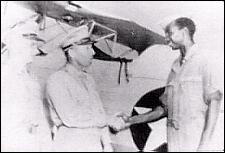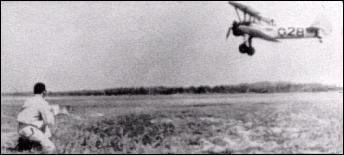|
|
|
|
|
|
|
|
|
|
The Black American Becomes
A Fighting Airman
|
Blacks had been attempting to gain entrance into the Army Air Corps
since World War I. Senators Harry Swartz of Wyoming and Styles Bridges
of New Hampshire were in the forefront of those in Congress who championed
the cause of blacks to serve in the Air Corps.
Public Law 18, approved April 3, 1939, provided for the large-scale
expansion of the Air Corps, with one section of the law authorizing the
establishment of training programs in 6 black colleges to employ blacks
in various areas of Air Corps support services.
One such college was designated as a training center for black pilots
and support personnel. Race and color were not the only barriers that blacks
faced in pursuit of training in the Air Corps. The fact that there were
no blacks to train them meant that there must be an element of racial integration
if the program were to get started.
On Jan. 16, 1941, the War Department announced the formation of the
99th Pursuit Squadron, a black flying unit, to be trained at Tuskegee,
Ala., the home of the Tuskegee Institute. |
|
 |

Student pilot being congratulated
upon completion of primary flying course at Moton
Field. |
|
That same month, the Secretary
of the Army announced that, since there were no black officers in the Air
Corps, 11 white officers would be assigned the duty of training 429 enlisted
men and 47 officers as the first black military personnel in the flying
school. Thus the "Lonely Eagles," as the black pilots were to call themselves,
became a reality.
World War II Achievements: The 99th Pursuit
Squadron, which was later named the 99th Fighter
Squadron, fought throughout the Mediterranean
and European Theaters and became a respected
group of fighter pilots.
Perhaps the unit's greatest claims to fame were:
(l) as a bomber escort group that protected
American bombers on their missions deep into
Europe, the 332nd, which the 99th was assigned,
never lost a bomber to enemy fighters; and
(2) the unit was responsible for the formation
of several other black Air Corps units,
including fighter, bomber and composite
squadrons and groups. In June 1943, Lt. Charles
Hall of Indiana became the first member of the
99th to shoot down a German plane. He was
personally congratulated by General Eisenhower
who was in the area at the time. |
|
|
|
|
|
|

Grading a primary student at Tuskegee on his solo
landing. |
From the inception of
the 99th through the period that signaled the
ending of World War II (1946), the following
numbers of black combat flyers completed their
training: 673 as single-engine pilots, 253 as
twin-engine pilots, 58 as liaison field
artillery of ficers, 132 as navigators.
The bulk of black flyers were in the 332nd
Fighter Group, which consisted of the 99th
Fighter Squadron; the 100th Fighter Squadron;
the 301st Fighter Squadron; the 302nd Fighter
Squadron; the 616th Bombardment Squadron; the
617th Bombardment Squadron; the 618th
Bombardment Squadron and the 619th Bombardment
Squadron.
There was also the 477th Bombardment Group
(medium), which consisted of the 99th Fighter
Squadron; the 616th Bombardment Squadron; the
618th Bombardment Squadron and the 619th
Bombardment Squadron.
|
|
The bombardment squadrons were
equipped with B-26 aircraft and later with B-25s. Campaigns of the 332nd Fighter
Squadron included Sicily; Naples-Foggia; Anzio; Rome-Arno; Normandy; Northern
France; Southern France; North Apennines; Rhineland; Central Europe; Po Valley;
Air Combat-EAME Theatre. Decorations of the 99th Fighter Squadron were
Distinguished Unit Citations for Sicily, June-July, 1943; Cassino, May 12-14,
1944; Germany, March 24, 1945.
First Victory: Charles B. Hall,
Brazil, Ind., became the first black fighter pilot to down an enemy aircraft
July 21, 1943. While escorting B-25 bombers over Italy on his eighth mission,
Hall spotted two Focke Wulf Fw190s approaching after the bombers had dropped
their bombs on the enemy-held Castelvetrano airfield. He quickly maneuvered into
the space between the bombers and fighters and turned inside the Fw190s. Hall
fired a long burst at one of the Fw 190s as it turned left. After several hits,
the aircraft fell off and crashed into the ground. |
|

A class of twin-engine pilots in front in flight caps
and
single engine pilots in rear in helmets and goggles, Dec. 1943. |
|
|
|
|
|
| |
©AvStop
Online Magazine
Contact
Us
Return To News

|
| |
|
|

|





